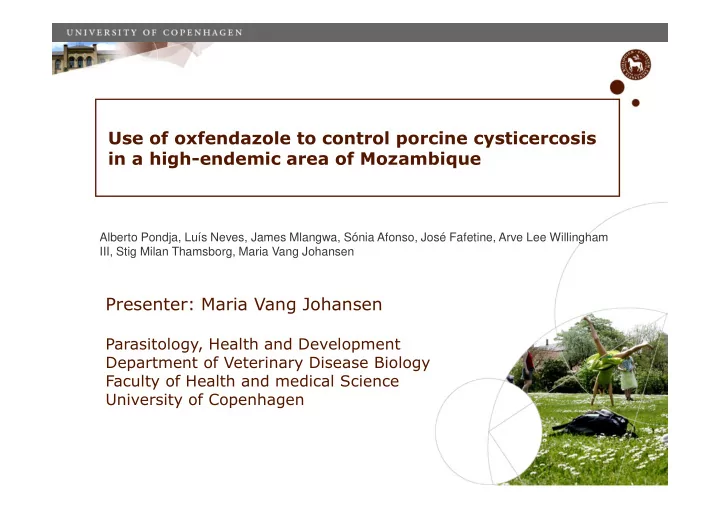

Use of oxfendazole to control porcine cysticercosis in a high-endemic area of Mozambique Alberto Pondja, Luís Neves, James Mlangwa, Sónia Afonso, José Fafetine, Arve Lee Willingham III, Stig Milan Thamsborg, Maria Vang Johansen Presenter: Maria Vang Johansen Parasitology, Health and Development Department of Veterinary Disease Biology Faculty of Health and medical Science University of Copenhagen
Tete Province–Angonia district Background Area: 3 277 km2 Altitude: 700 to 1655 m (MAE, 2005) Households: 81 645 In Mozambique, data on cysticercosis is scarce and fragmented CESA project from 2006 – 2010 Prevalence and associated risk factors for T.solium cysticercosis in Angónia district, Mozambique assessed in 2009 1. T. solium cysticercosis is endemic in the region Porcine Ag-ELISA B158/B60 : 231/661 (35%) Human Ag-ELISA B158/B60 : 243/1723 (15%) 2. Increasing pig age and pig husbandry practices contribute significantly to PC transmission T. solium cysticercosis is endemic in the region (Pondja et al. 2010)
Meat inspection?
Study objective Evaluate the effectiveness of a single oral dose of 30 mg/kg of oxfendazole treatment for control of porcine cysticercosis
Methodology Ethical clearance from scientific board at Veterinary Faculty, Eduardo Mondlane University •Approach to local authorities & population: – Community leaders (willingness to participate) – Basic ethical principles explained to participants – Willingness to raise study pigs – Informed consent – OIE’s Terrestrial Animal Health Code for the use of animals in research and education
Methodology A randomized controlled field trial 4 rural villages of Angónia district (Camuetsa, Campessa, Ndaula, Lilanga) 216 pigs 4 month of age Obtained from 54 litters from 54 farms in the area T1: 54 pigs – treat OFZ month 4 T2: 54 pigs – treat OFZ month 9 C : 108 pigs – litter matched controls
Methodology 9 12 4 Bleed all + treat T1 Bleed all + treat T2 Bleed all + kill 30 30 randomly selected pigs (8 from T1, 8 from T2 and 14 from control group) purchased from villagers, slaughtered locally and dissected for assessment of T. solium cysticerci. Oxfendazole: 30 mg/kg p.o. (Oxfen-C Beyer, South Africa). Blood samples for Ag-ELISA collected before T1 (m 4), T2 (m 9) and month 12. Ag-ELISA: B158/B60 (Dorney et al. 2002).
Results Pig race: Landim Males: 55%, Females 45% 46 pigs lost to follow up (24 control, 12 T1 and 10 T2 group) Baseline prevalence 5.1 % (95% CI = 2.6% – 8.9%) no sig. diff between groups (p > 0.05)
Results - effectiviness Age Control group T1 group T2 group Number Prevalence Number Prevalence Number Prevalence tested (%) tested (%) tested (%) 4 months 108 5.6 54 5.5 54 3.7 9 months 90 33.3 44 13.6 50 36.0 12 months 84 66.7 42 21.4 44 9.1 Control : Significant increase from 4 to 9 and from 9 to 12 • month (p < 0.001). T1 : Increase from 4 to 12 but significantly lower than control (p • < 0.001). T2 : Significant increase from 4 to 9 months (p < 0.001) and • significant decrease from 9 to 12 months (p < 0.01).
Results - incidence study At baseline, 205 pigs from all groups were negative by Ag-ELISA Period Number of cases per 100 pigs-month Control group T1 group T2 group 1 (between 1 st and 2 nd sampling) 2.2 1.1 2.9 2 (between 2 nd and 3 rd sampling) 11.5 2.1 1.6 T1 and T2 had lower incidence rates than control during the follow-up (p < 0.05) • All infected pigs at the time of treatment were found negative in the subsequent • sampling round
Results - Multivariate logistic regression Odds Factor 95% CI p-value Ratio Treatment Control 1 group OFZ-T1 0.14 0.05 - 0.36 <0.001 OFZ-T2 0.05 0.02 - 0.16 <0.001 Sex Female 1 Male 1.02 0.47 - 2.22 0.95 Free range No 1 Yes 1.76 0.38 - 8.20 0.47 Village Camuetsa 1 Campessa 1.12 0.34 - 3.68 0.85 Ndaula 1.09 0.40 - 2.95 0.87 Lilanga 1.06 0.23 - 4.81 0.94
Conclusion Treatment of pigs with oxfendazole in the last part of the fattening period is cost-effective in controlling porcine cysticercosis in endemic low-income areas but should be integrated with other control measures.
Acknowledgements • Bayer-South Africa for providing the drug • The Serviços Provinciais de Pecuária de Tete • Serviços Distritais de Agricultura de Angónia • Estação Zootécnica de Angónia • Community authorities • Pig farmers • Danida - SLIPP-project (Securing rural Livelihoods through Improved smallholder Pig Production in Mozambique and Tanzania)
Recommend
More recommend